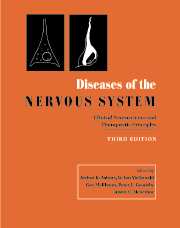Book contents
- Frontmatter
- Dedication
- Contents
- List of contributors
- Editor's preface
- PART I INTRODUCTION AND GENERAL PRINCIPLES
- PART II DISORDERS OF HIGHER FUNCTION
- PART III DISORDERS OF MOTOR CONTROL
- PART IV DISORDERS OF THE SPECIAL SENSES
- 41 Smell
- 42 Taste
- 43 Disorders of vision
- 44 Oculomotor control: normal and abnormal
- 45 Disorders of the auditory system
- 46 Vertigo and vestibular disorders
- PART V DISORDERS OF SPINE AND SPINAL CORD
- PART VI DISORDERS OF BODY FUNCTION
- PART VII HEADACHE AND PAIN
- PART VIII NEUROMUSCULAR DISORDERS
- PART IX EPILEPSY
- PART X CEREBROVASCULAR DISORDERS
- PART XI NEOPLASTIC DISORDERS
- PART XII AUTOIMMUNE DISORDERS
- PART XIII DISORDERS OF MYELIN
- PART XIV INFECTIONS
- PART XV TRAUMA AND TOXIC DISORDERS
- PART XVI DEGENERATIVE DISORDERS
- PART XVII NEUROLOGICAL MANIFESTATIONS OF SYSTEMIC CONDITIONS
- Complete two-volume index
- Plate Section
42 - Taste
from PART IV - DISORDERS OF THE SPECIAL SENSES
Published online by Cambridge University Press: 05 August 2016
- Frontmatter
- Dedication
- Contents
- List of contributors
- Editor's preface
- PART I INTRODUCTION AND GENERAL PRINCIPLES
- PART II DISORDERS OF HIGHER FUNCTION
- PART III DISORDERS OF MOTOR CONTROL
- PART IV DISORDERS OF THE SPECIAL SENSES
- 41 Smell
- 42 Taste
- 43 Disorders of vision
- 44 Oculomotor control: normal and abnormal
- 45 Disorders of the auditory system
- 46 Vertigo and vestibular disorders
- PART V DISORDERS OF SPINE AND SPINAL CORD
- PART VI DISORDERS OF BODY FUNCTION
- PART VII HEADACHE AND PAIN
- PART VIII NEUROMUSCULAR DISORDERS
- PART IX EPILEPSY
- PART X CEREBROVASCULAR DISORDERS
- PART XI NEOPLASTIC DISORDERS
- PART XII AUTOIMMUNE DISORDERS
- PART XIII DISORDERS OF MYELIN
- PART XIV INFECTIONS
- PART XV TRAUMA AND TOXIC DISORDERS
- PART XVI DEGENERATIVE DISORDERS
- PART XVII NEUROLOGICAL MANIFESTATIONS OF SYSTEMIC CONDITIONS
- Complete two-volume index
- Plate Section
Summary
Taste modifies the act of eating, and subsequently has a tremendous impact on one's behaviour and well-being. The physiologic role of the gustatory system is multifold and includes: (a) triggering ingestive and digestive reflex systems that alter the secretion of oral, gastric, pancreatic, and intestinal juices (Schiffman, 1997; Giduck et al., 1987), (b) reinforcing the ingestive process by enhancing the feelings of pleasure and satiety (Warwick et al., 1993), and (c) enabling the individual to determine the quality of sampled foodstuffs and distinguish nutrients (which usually taste ‘good’) from potential toxins (which usually taste ‘bad’) (McLaughlin & Margolskee, 1994; Scott & Giza, 1995). Although rarely appreciated, gustatory dysfunction can alter food choices and patterns of consumption, resulting in weight loss, malnutrition, and possibly impaired immunity (Schiffman & Wedral, 1996; Mattes & Cowart, 1994). Increased sensitivity and aversion to bitter-tasting substances on the part of the pregnant mother during the first trimester presumably reflects the need to detect and avoid bitter tasting poisons and teratogens during this critical phase of fetal development. Similarly, increased preferences for salty and bitter tasting substances during the remainder of pregnancy likely encourage the eating of a varied diet and the ingestion of much needed electrolytes to expand fluid volume (Duffy et al., 1998). In someone who is hypertensive or diabetic, taste loss can lead to a dangerous tendency to over-compensate for the loss by adding additional salt or sugar to the food.
In this chapter, we review clinically important aspects of the anatomy and physiology of the gustatory system, describe approaches for quantitatively evaluating this system, and present examples of common types of gustatory dysfunction, along with means for their management or treatment.
Anatomy and physiology
Taste buds, papillae, and initiation of taste transduction
The ̴ 4600 goblet-shaped taste buds are located on the tongue's dorsal surface, the tongue–cheek margin, the base of the tongue, the soft palate, the pharynx, the larynx, the epiglottis, the uvula, and the first third of the esophagus (Miller, 1995). Most are found on the surface of the tongue within the protruding papillae. The fungiform, foliate and vallate (also called circumvallate) papillae harbor most of the taste buds; filiform papillae do not (Fig. 42.1).
- Type
- Chapter
- Information
- Diseases of the Nervous SystemClinical Neuroscience and Therapeutic Principles, pp. 610 - 620Publisher: Cambridge University PressPrint publication year: 2002
- 3
- Cited by

